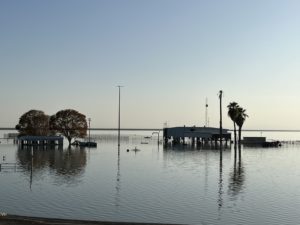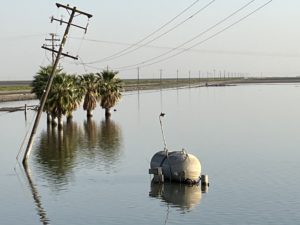The 2023 winter and spring storms caused significant and historic damage throughout the state. In Tulare County, recovery is ongoing. The California Governor’s Office of Emergency Services (Cal OES) continues to work with state and local partners on monitoring Tulare Lake and surrounding waterways that still haven’t receded to pre-storm levels.
Throughout the response period, Cal OES and local partners provided resources to aid residents affected by flooding in Fresno, Kern, Kings and Tulare counties.
“Here in Tulare County, we are still recovering. We were able to get our cleanup finished where we worked with Cal OES for our debris removal program following floods this spring,” said Monterio.
Other response and recovery efforts included raising local roadways for rural communities, strategically placing super sacks in waterways and opening disaster recovery centers. Cal OES also activated the State Flood Operations Center, emergency declarations were issued in 53 counties and the National Guard was mobilized.

Tulare Lake| September 2023
As a method to expedite water dispersal, reclamation districts have been moving water from Tulare Lake to nearby farmlands within Kings County. Evaporation has also played a key role in reducing the flood waters.
Following months of coordinated efforts to combat flooding, Tulare Lake has significantly shrunk in size.
Residents of surrounding counties are recovering and preparing for what could come next. Carrie Monteiro, a Public Information Officer for Tulare County Health and Human Services Agency said, “We’re here leaning on each other, helping those in need, helping each other out, helping rebuild from the floods back in spring. And the lake’s going to be here to stay.”
Among the many challenges, stagnant water creates conditions that can boost local mosquito populations, leading Cal OES to continue assisting with mosquito abatement operations in the surrounding areas, conducting surveillance, flyovers and treatment.
Monteiro said, “So the counties have been working a lot with Cal OES and other partners at the state to do surveillance, flyovers and treatment to help manage the mosquito populations.”
Tulare Lake in California has been mostly dry for the last 100 years. The last time the lake returned in a significant way was in 1983, and it lasted for two years before disappearing again.
2023 Emergency Response Statistics
Initial response actions included:

Tulare Lake| September 2023
- Distributing 1.88 million sandbags
- Deploying 12,000 feet of muscle walls
- Supplying 59 million pounds of rock and sand for reinforcement
- Opening 60 shelters
- Providing 850 comfort kits
- Maintaining 3.5 million miles of roads
- Removing 590 million cubic yards of snow
- Making 2 million phone calls for flood awareness
- Registering 46,000 households for local alerts
Video from Tulare Lake from September 2023
[Video]
For more information about Tulare Lake response and recovery operations:
Tulare Lake Receding Due to Coordinated Action & Favorable Weather | Cal OES News
Central Valley Recovery Efforts: The Return of Tulare Lake | Cal OES News
